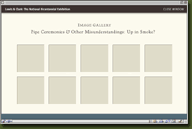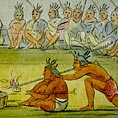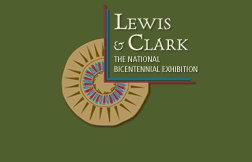
IMAGE GALLERY
 |
 |

Access the Image Gallery to see all images, objects, and documents used in this lesson plan.
 |
View Image Gallery

|

|
 |



Lesson Plan 3: The Teton Confrontation—First Test for Diplomacy
OBJECTIVES
Students will:
- describe Lewis and Clark's encounter with the Teton Sioux
- use content vocabulary correctly
- read and draw inferences from primary documents
- identify problems Lewis and Clark had with diplomatic strategies during this encounter
MATERIALS
PROCEDURE
 Present the content vocabulary to the students by reading the following paragraph and then posting the vocabulary where it can be seen and referred to for the duration of the unit: Present the content vocabulary to the students by reading the following paragraph and then posting the vocabulary where it can be seen and referred to for the duration of the unit:
President Jefferson asked Lewis and Clark to go on a mission of diplomacy (meaning to manage relations between the United States and Indian tribes.) Diplomacy is an art (meaning that some people have a natural talent for doing it well) but it is also a skill (meaning you can learn to do it by studying and practicing.) As diplomats (meaning people who talk and deal with others to get something they need or want), Lewis and Clark would have to learn how to be tactful (meaning having a sharp sense of the right things to say and do to avoid offending the Indians and to gain their good will.)
- Read the narrative "The Teton Confrontation" to the students. [S18]
It might be a good place to break the lesson after reading this narrative.
- After reading the narrative, tell the students:
"Today we are going to work in groups, rereading parts of the story I've just read to you. You will also read some journal entries written by William Clark that record in his own words what happened during the Teton Sioux Encounter. Journal entries like these are called primary sources and even though they are written in 'old-fashioned' language they can help us understand what Clark saw and how he felt about these events."
To help students who may not have used primary resources before you may want to use the following instruction prior to doing this group activity:
- Write this quotation from Clark's journal on the board or an overhead:
William Clark, September 25, 1804
"....all well, raised a Flag Staff & made a orning or Shade on a Sand bar in the mouth of Teton River, for the purpose of Speeking with the Indians under.."
Read or have someone read the above quote and say:
"This is a sentence taken directly from someone's journal. Does anything about it look strange to you?"
Students will probably comment on the spelling and mechanical errors.
"Who do you think wrote it?"
This is an excerpt from William Clark's personal journal.
"When and where did he write it?"
Clark wrote this on the morning of September 25, 1804, on a sand bar in the Teton River.
"What does it mean?"
It means that Lewis and Clark had set up a place to meet the Teton Sioux Indians on a sand bar in the river. They had put up an awning for shade and a flag to show they were representing the United States, and they were waiting for the Indians to arrive.
- Continue with the directions for group work by telling students that as they work in their groups and read, they should be looking for clues to any diplomatic strategies the captains tried in dealing with the Sioux. They should try to determine if Clark was or was not happy with the results of the meetings with the Teton Sioux. Each group will receive part of the story that tells about one day of the encounter. (The journal entries in the packets have been "cleaned up" for spelling and mechanical errors to make them easier for students to read and understand them.)
- Divide the students into groups of four with the following roles:
Reader: will read the story and journal excerpts to the group.
Questioner: will ask the questions from the organizer form.
Recorder: will write the answers on which group members agree.
Reporter: will report to the class the group's answers.
- Distribute a piece of the story and a Clue Sheet to each group. (pages L3/D, L3/D4, L3/D5, L3/D6, L3/D7). Have students read, discuss, and record their findings on their Clue Sheet forms:
- examples of the four diplomatic strategies (gift giving, chief making, speech making, and shows of strength/ceremonies.)
- William Clark's changing feelings over the period of each day based on clues from his journal entries.
- Give students about twenty minutes to work.
- Call the groups back together and have the reporter from each group summarize what they have written and give evidence from their readings to support their conclusions about Clark's feelings about the encounter (start with Monday's group, go to Tuesday's, etc.)
- Then play the video clip of Jeanne Eder in which she speaks about her perception of the Teton Sioux encounter with Lewis and Clark in September of 1804. Ask: "According to Ms. Eder, what did the Sioux think of Lewis and Clark?"
- Discuss with the students the differences in Jeanne Eder's view and Clark's.
CLOSING
Ask students to write a statement about what they think made some strategies more successful than others. Share with the class.
SUGGESTED FORMATIVE ASSESSMENT
Have each student construct a Venn diagram comparing the Teton Sioux encounter with the Shoshone encounter.
[PRINTABLE VERSION]
|
 |







